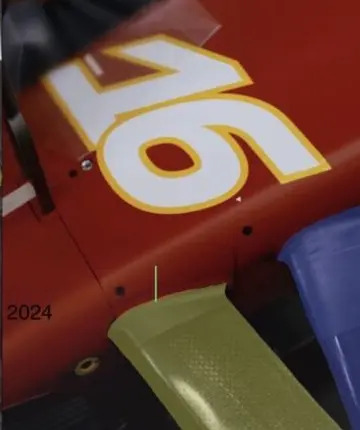Proofs, sustained explanations that pull-push is overall better than push-pull?
Anyone?
- Login or Register
No account yet? Sign up
Rear push moves the mounting point to the top of the gearbox freeing up space to shrink the bottom of the gearbox, which opens up more space for the diffuser --> more downforce. On the front I think in general it's just preference of how you want to shape the airflow.
Far too many different mechanical and aerodynamic characteristics of the respective designs.
Well, that's the point, instead of claims that Ferrari goes conservative and bla, bla, bla.chrstphrln wrote: ↑12 Feb 2024, 15:13Far too many different mechanical and aerodynamic characteristics of the respective designs.
Simply copying and adapting to your own technical layout, the specific weight distribution or your own aerodynamic concept probably makes a simple black and white viewing impossible.
It’s very obvious from the pic of the ‘24 AMR what could be one reason Ferrari avoided going the push-rod: due to the rules imposing all upper and lower wishbone joints above the wheel centreline, the push-rod is almost horizontal. I expect this will result in very small motion ratio at the inboard end from a vertical bump displacement so requiring a larger rocker ratio to get decent damper displacement and reduce loads on the pushrod itself and at the cost of some springing and damper precision.
I don't want to you to eat these words but then again history is not on our side with Ferrari.CouncilorIrissa wrote: ↑12 Feb 2024, 14:55I view them sticking to pull-rod at the rear as a good thing, tbh. No one is getting close to RB, let alone beating them by doing the same thing as them due to a 2-year head start that they have on everybody.
I might end up eating these words in 10 days, though.
Indeed, nice catch and thanks for sharing!ing. wrote: ↑12 Feb 2024, 15:38It’s very obvious from the pic of the ‘24 AMR what could be one reason Ferrari avoided going the push-rod: due to the rules imposing all upper and lower wishbone joints above the wheel centreline, the push-rod is almost horizontal. I expect this will result in very small motion ratio at the inboard end from a vertical bump displacement so requiring a larger rocker ratio to get decent damper displacement and reduce loads on the pushrod itself and at the cost of some springing and damper precision.
Compare this to the much more vertical pull-rod orientation being more aligned with the vertical loads and motion of the rear suspension that need to be controlled.
The RB carries way more angle/leverage advantage in pushrod form than that example given. It doesn't appear to be any more limited than the typical pull rod orientation from that aspect.ing. wrote: ↑12 Feb 2024, 15:38It’s very obvious from the pic of the ‘24 AMR what could be one reason Ferrari avoided going the push-rod: due to the rules imposing all upper and lower wishbone joints above the wheel centreline, the push-rod is almost horizontal. I expect this will result in very small motion ratio at the inboard end from a vertical bump displacement so requiring a larger rocker ratio to get decent damper displacement and reduce loads on the pushrod itself and at the cost of some springing and damper precision.
Compare this to the much more vertical pull-rod orientation being more aligned with the vertical loads and motion of the rear suspension that need to be controlled.


Roll Center change will be minimized if the rear pick-up point of the upper wishbone is lowered, which it probably will, for aero reasons and to maintain good camber gain.FDD wrote: ↑12 Feb 2024, 22:02Zander Arcari:
"Ferrari SF-24, front push-rod: 1st arm raised to modify the roll center"
Probably also greater anti-dive effect.
https://www.funoanalisitecnica.com/wp-c ... 1.jpg.webp
https://www.funoanalisitecnica.com/wp-c ... 4.jpg.webp